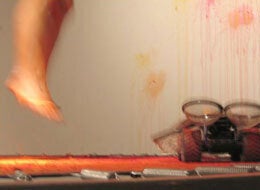

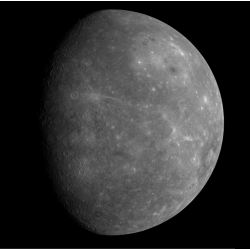
TOP: Still from the movie Barbarella starring Jane FondaBOTTOM: MESSENGER's First Look at Mercury's PreviouslyUnseen Side, Release Date: January 15, 2008.
Any artist who has the vision to seize this quote made by "Virgin" Founder Sir Richard Branson-- that he busted the stitches from a circumcision while watching Barbarella-- and then let this comment help inspire a performance art piece and show, deserves my full and undivided attention. Surely Mr. Branson mentioned this after a drink or two during an interview about, I dunno, maybe those shaggalicious purple neon lights in his new Virgin America planes, but probably his foray into space tourism with Virgin Galactica. In any event, given the recent images of the unseen face of Mercury beaming at us on the news these days, Artist Carrie Paterson's latest work offers the perfect prism through which to view them.
Exploration has always been gendered. Ships are always "She," even the phallus' we shoot in the sky, even the "Enola Gay"! So if space exploration is indeed the final frontier, how might an artist represent the gender issue into the searching, yearning, and our need for national, imperialistic expansion? Through performance pieces, functional installations, and a series of postcards, Paterson uses space in order to question its relationship to femininity and neocolonialism. Paterson simultaneously highlights concurrent events, such as the memorial for NASA's Columbia and the United States' invasion of Baghdad. In either case, Paterson invites the viewer to participate in the process of exploration, whether using her body as the vessel of exploration, or pointing to the gendered nature of the final frontiers of space and expansion.
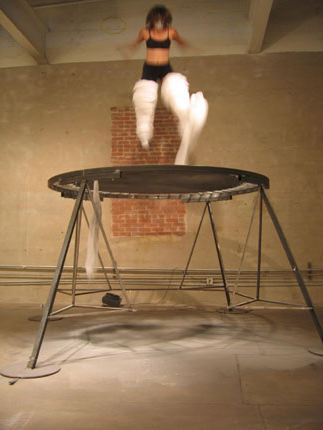 "Unforseen Initiatives to Deterritorialize the Self". Performance 2005, Carrie Paterson,Custom trampoline 6 feet x 14 feet in diameter and 120 foot acetate stockings, chalk, slide projector.
"Unforseen Initiatives to Deterritorialize the Self". Performance 2005, Carrie Paterson,Custom trampoline 6 feet x 14 feet in diameter and 120 foot acetate stockings, chalk, slide projector.
Kimberly Brooks: So what exactly set you on the path of the space and gender as a theme?
Carrie Paterson: Even though it's hard to name a single inspiration for my current trajectory of research, reading the quote from Branson fascinated me. He actually said it was the basis for his inspiration to explore the frontier of space tourism (see Wired Magazine a few years ago for the exact quote). The idea that an aerospace magnate could actually make these one-to-one comparisons between Jane Fonda's body and the stratosphere is really amazing to me. It's a kind of crystallizing moment in terms of why I'm proceeding with a type of social critique through what people are doing and saying about outer space. The study of gender in that realm leads to many things including thinking about neocolonialism and the militarization of space. Below is an image of the "Gravitational Effects on Sperm Production, Motility & Fertilization" is from a NASA website, for example.
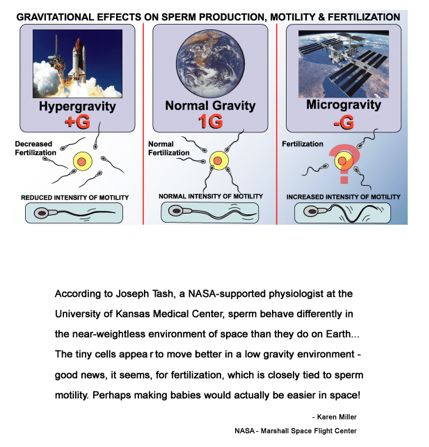 NASA Pregnancy, From "Learn to See the Moon in Color" postcards and double-sided light boxes,Carrie Paterson, 2007, 6 x 4 inches and 12 x 9 x 6 inches.
NASA Pregnancy, From "Learn to See the Moon in Color" postcards and double-sided light boxes,Carrie Paterson, 2007, 6 x 4 inches and 12 x 9 x 6 inches.
KB: Nice to see our tax dollars at work. You have an unusual combination of three-dimensional artworks that are also functional objects. How do you tie gender in with these objects?
CP: In thinking about the connection between the "heavenly bodies" and representations of women I've been combining a research-based approach with actual objects people can use. I've started producing perfume bottles that are models of the solar system, for example. And I've also created a moon-landing trampoline.
KB: Really? Are you making perfume for them?
CP: There will be perfumes. I'm working on scent-creation now so it's hard to say. Probably I won't go hard-core methane and sulphur like the composition of planets though.
KB: Everyone will appreciate that. Tell us about the elevator in your show, what does that signify, aside from being another kind of vessel?
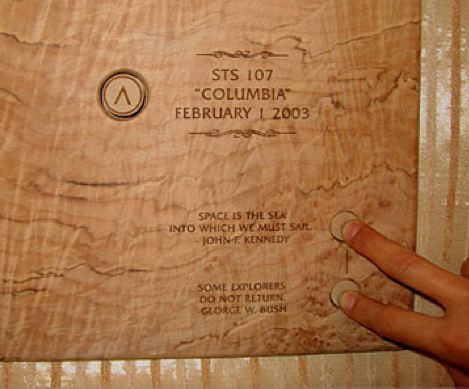 Elevator Button, From "PEGLEG: Up for War," mixed media installation, Carrie Paterson, 2004-2007.
Elevator Button, From "PEGLEG: Up for War," mixed media installation, Carrie Paterson, 2004-2007.
CP: It's a functional elevator I made that also serves as a memorial for the Space Shuttle Columbia, who exploded on *her* return to Earth one month before the invasion of Baghdad. That piece has elevator music that samples President Bush's memorial speech, in which he seems to be readying the American public for the inevitable loss of soldiers in the war. It can be heard at http://www.uber.com/ElevatorMusic. Thinking about gender in relation to the wars in the Middle East, one must remember that the previous time the US went to war with Iraq was to avenge what pundits were calling Saddam's "rape" of the Kuwaiti oil fields.KB: Yes, we could be here all day on that one. Do you like, or have you ever been obsessed with David Bowie? (Low, Space Oddity, Spiders from Mars, etc?)
CP: I like David Bowie. Obsession would be too strong of a word. In terms of past references I'm more interested in how outer space metaphors have found their way into Politics ie. Kennedy and - this is timely - the Reverend Martin Luther King. Are you familiar with his speech "dimensions of a complete life"? It's from 1962 - fantastic stuff. He seemlessly wove together themes from religion, space travel, the universe, and civil rights.
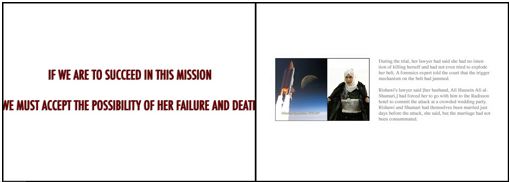 Conquering Space, From "Learn to See the Moon in Color," Carrie Paterson, series 2007,double-sided light box with artist's face text, and back text from the NY Times.
Conquering Space, From "Learn to See the Moon in Color," Carrie Paterson, series 2007,double-sided light box with artist's face text, and back text from the NY Times.
KB: What are some of the steps you take in creating your works--whether performance or three-dimensional?
CP: I think my most interesting process is subconscious. I've had dreams of floating above the earth like an astronaut, seeing the world below me as a singular entity, a kind of Gaia-vision, and then feeling a sudden weight in my stomach and the rest of the dream is just falling. To fall toward Earth and never reach Earth... it's kind of like falling in love--an exhilaration at the same time as an endless sadness. I think a lot of my work is coming to terms with the things I see around me that are caught in this type of struggle--a desire to escape but always being defined by gravity, the weight of the body, its chemistry and relationships to other bodies. As a country we have strange notions about independence and power--and I feel this national myth has serious repercussions on the way we think and feel collectively about women.
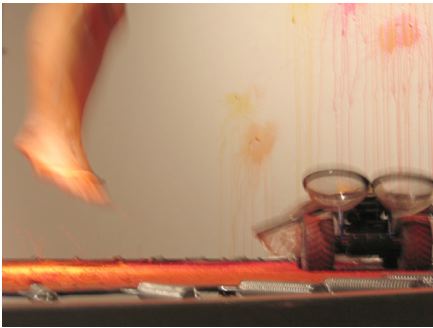 Mars Trampoline, "Several Attempts to Make Images of the Moon and Mars by Landing on Them," Carrie Paterson, Performance 2006.
Mars Trampoline, "Several Attempts to Make Images of the Moon and Mars by Landing on Them," Carrie Paterson, Performance 2006.
KB: How does the performance aspect illuminate your research?
CP: In the performance on the trampoline I tried to draw the image of the moon in chalk on the mat while jumping. That image historically has been a metaphor for the female body and I was interested in the relationship of my image to *hers*. Every time I landed I would destroy what I had made, but would sift part of the drawing onto the floor, which after an hour, became another sort of drawing - a landscape of failed attempts. I also made one trying to land on Mars, using chalk and tempura paint. Both drawings privileged the movement and action of my body over a static image that could be easily seized by the eye. I think I'm trying to do two things at the same time that aren't necessarily comfortable bedfellows. I'm trying to make audiences think critically as well as move them in some way. My performance-based works are all really visceral so people experience disorienting physical sensations - from claustrophobia to bouncing to vertigo - that make it more difficult for the rational mind to function as if there were no body attached.
KB: What do you think of the Messenger's new shots of Mercury? How does it resonate with your work?
CP: It actually reminds me of an excellent sci-fi movie I just saw by Danny Boyle (of Trainspotting and 28 Days Later) that does relate to my work. It's called Sunshine. The tie-in to Mercury is plot-related. In the film, the ship Icarus II uses Mercury's gravitational field to slingshot toward our dying Sun, where the crew will complete their suicide mission to save the Earth by detonating a nuclear bomb at the core. In terms of phenomenology and science fiction, it demonstrates that through art/film about space people are able to experience a bodily-response to images. The crux of the plot is about the light of the sun and we as the audience are constantly bathed in it at key points. Privileging the body as an instrument of comprehension has implications toward gender equality, my logic goes.
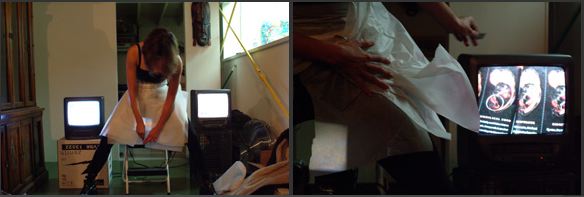 Carrie Paterson, Stanley, Throw Me A Bone, November 9, 2002, 3-channel video and performance, "Whacked" curated by John Souza, Practice Space, Los Angeles.
Carrie Paterson, Stanley, Throw Me A Bone, November 9, 2002, 3-channel video and performance, "Whacked" curated by John Souza, Practice Space, Los Angeles.
The film also has problematic racial representations. The crew is a mixed Chinese/American crew (based on the idea that these two countries will have the most advanced space programs in 50 years) but somehow all the Chinese crew members are expendable on the mission. The underlying messages are about an American dominance in space, as well as a Christian one. The martyr/Christ-complex about saving the world by literally touching the sun interestingly also co-opts the instrument of the "suicide bomber" - the whole thing just has me reeling. It was so beautiful and "ingestible", Kubrickian and apocalyptic. Shall we say, a very patriarchal logic? I've used these ideas before in an earlier performance entitled "Stanley, Throw Me a Bone."
KB: I'd like to see that performance, is it online?
CP: Not yet.
KB: What other artists inspire you besides Stanley Kubrick, MLK, JFK and Sir Richard Branson?
CP: Anything by Gordon Matta-Clark. 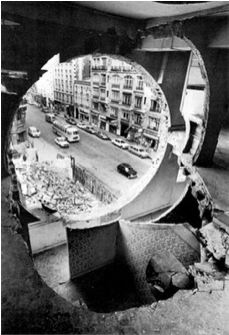 Conical Intersect (detail), 1975, Gordon Matta-Clark (1943-1978)
Conical Intersect (detail), 1975, Gordon Matta-Clark (1943-1978)
Carrie Paterson is an artist and writer based in Los Angeles. Her sculpture, new media and performance works have been seen in museums, universities, non-profit galleries and online spaces, primarily in North America. Her archive is at www.cpworks.org. Watch for information about upcoming shows from her "Out of Space, Out of Time" series in Los Angeles. --
First Person Artist is a weekly column by artist Kimberly Brooks in which she provides commentary on the creative process and showcases artists' work from around the world. Come back every Saturday for more Kimberly Brooks. You can view all the columns and essays at www.firstpersonartist.com
